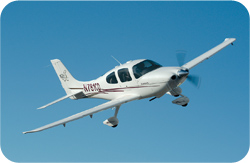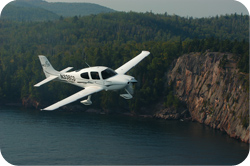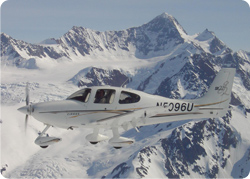| |
|
|
|
| |
SPINS: A Personal Viewpoint
By: Kathleen Bangs
 During my tenure as a single-engine airplane flight instructor,
nobody could have ever said that I didn’t like to take an
airplane up for a spin, literally. During my tenure as a single-engine airplane flight instructor,
nobody could have ever said that I didn’t like to take an
airplane up for a spin, literally.
If there was a spin-approved airplane available, my students
were going to spin it, all while I extolled the virtues of effective
spin training and recoveries. No passive ‘spin demonstrations’ from
an instructor – at least in my mind - satisfied the spin
requirement. Rather, I made even my private pilot applicants prove
to me, and more importantly to themselves, that they were comfortable
with getting into and out of spins. To make it more interesting,
we called them precision spins, and little leeway was given as
the applicants worked hard to recover from three-turn spins on
exact pre-determined headings.
But after I left the flight instructor ranks and flew for an
increasingly larger series of commercial air carriers, I never
thought much about spins again, until one beautiful sunny Sunday
afternoon in Oklahoma.
As I banked my Boeing-727 onto a straight-in visual for one of
two parallel north-south runways, our approach controller said
farewell and remarked for us to enjoy our view of a large airshow
presently taking place at the airport. The other parallel runway
was playing host for the festivities which had drawn over 100,000
spectators.
Inside the final approach fix, all eyes in our cockpit were fixed
on a low-wing monoplane performing a series of precision aerobatic
maneuvers. After climbing for additional altitude, the airshow
pilot kicked the plane over into a spin. After eight or nine rotations
I said to the other two crewmembers, “he’s going to
crash – there’s not enough altitude to recover.” They
tsk-tsk’d me, saying “It’s just part of the show!”
By this time we were into the landing flare the show was obscured
by the terminal building. I pulled the big three throttles to idle,
and after touchdown we taxied to the gate. Across the field a black
smoke plume rose into the sky, marking the spinning airplane’s
impact point with the ground.
 I was surprised, but not shocked. A discussion with a former
instructor of mine – himself an accomplished airshow pilot – revealed
that he’d once had a startling experience while doing routine
spins in a popular four-place high wing trainer, something he’d
done in his own words, “hundreds of times before.” But
on that particular day, the plane “wrapped-up” on him,
and he’d been initially unable to get it to recover from
the spin. He reported using the same inputs that previously had
been very effective, yet the plane kept spinning. After seven revolutions,
it finally recovered. He was a man of few words, so for him to
mention this at all gave it significance. What he added, which
I never forgot, was his opinion that on some days, for some unforeseen
variable – maybe just a slight shift in CG, a small dent
here or there, or even perhaps an imperceptible change of control
input – for whatever reason – an airplane can enter
a spin, like it has countless times before, and then refuse to
recover. I was surprised, but not shocked. A discussion with a former
instructor of mine – himself an accomplished airshow pilot – revealed
that he’d once had a startling experience while doing routine
spins in a popular four-place high wing trainer, something he’d
done in his own words, “hundreds of times before.” But
on that particular day, the plane “wrapped-up” on him,
and he’d been initially unable to get it to recover from
the spin. He reported using the same inputs that previously had
been very effective, yet the plane kept spinning. After seven revolutions,
it finally recovered. He was a man of few words, so for him to
mention this at all gave it significance. What he added, which
I never forgot, was his opinion that on some days, for some unforeseen
variable – maybe just a slight shift in CG, a small dent
here or there, or even perhaps an imperceptible change of control
input – for whatever reason – an airplane can enter
a spin, like it has countless times before, and then refuse to
recover.
That changed my perception on spins, and my previously somewhat
cavalier attitude of regularly performing them with anybody, sans
parachutes, and in any spin-approved airplane. It gave me a respect
that perhaps all spins belong only in fully aerobatic airplanes,
with parachutes, and so as to avoid the fate of that Oklahoma airshow
pilot - with enough altitude underneath to provide options.
A spin can be considered a near out of control maneuver. You
may be in control right up until the point that the plane enters
a full spin, and you may be in control from the moment after you
initiate the spin recovery and the airplane responds. But during
that in-between time – when the plane is in a fully developed
spin – there really is no guarantee you’re in control
and that it is going to recover.
Because my new perception on spins caused me to view them as
the most potentially dangerous of all airplane maneuvers, I also
had to re-evaluate the idea of spin education and training. Do
I now today still think it’s a good idea for pilots to experience
spins from the windscreen vantage point, as opposed to the more
passive view of a textbook or lecture? No. I still think it’s
a great idea.
A great idea, with a few caveats to consider beforehand. The
vast majority of Certified Flight Instructors have had very little
formal spin training. When aviation researcher and pilot Dr. Patrick
Veillette conducted a detailed stall/spin survey, he found that
98% of the responding flight instructors stated their spin training
consisted of no ground training and just two spins (one in each
direction) before they were endorsed as being proficient to teach
spins. Further inquiry revealed that 95% of the respondents did
not receive training emphasizing the conditions that lead to inadvertent
spins, common student errors, spin aerodynamics, and the effects
of the flight controls in a spin.
What does this mean to you, as a potential spin training student?
That you could be handing over the responsibility for your safety
to a woefully inadequately prepared instructor. Does this mean
you should forego spin training? No, but you should seriously consider
hiring an instructor who was properly trained, and who can conduct
spins with you in a fully aerobatic airplane, complete with parachutes.
 Across the U.S. a number of reputable flight schools specializing
in aerobatics, upset training, and spin recoveries are available
to meet your particular training need and match you with an appropriate
instructor and airplane. This doesn’t mean shelving your
common sense. Pay attention to your instincts: if anything about
an instructor or an operator’s attitude, procedures or manner
seems questionable, then it’s time to train elsewhere. Ditto
for the maintenance on the equipment, including the parachutes – observe
if everything appears to be well-maintained and cared for. Across the U.S. a number of reputable flight schools specializing
in aerobatics, upset training, and spin recoveries are available
to meet your particular training need and match you with an appropriate
instructor and airplane. This doesn’t mean shelving your
common sense. Pay attention to your instincts: if anything about
an instructor or an operator’s attitude, procedures or manner
seems questionable, then it’s time to train elsewhere. Ditto
for the maintenance on the equipment, including the parachutes – observe
if everything appears to be well-maintained and cared for.
As a new private pilot back in high school, I spent a summer
learning aerobatics with a very qualified instructor who was also
an active airshow performer. We always wore parachutes, and frequently
went through a verbal walk-through of the bail-out procedure. Being
a young, awestruck teenager, I never thought to question the possible
stupidity of wearing ancient military surplus parachutes on our
backs – if they were good enough for my instructor, who was
I to question?
The following season he told me he’d purchased new chutes
for his operation. The reason? During a repacking – which
admittedly may have not been accomplished in the previous two decades – the
lines to the canopy of the chute literally disintegrated in the
packer’s hands. I think my instructor’s exact words
went something like this, “they were dust – thank heavens
we never had to use them.”
In closing, spin training – like aerobatic training – is
an excellent confidence builder and an opportunity to experience
flying from a radically different perspective than straight-and-level
with banks limited to forty-five degrees. Aerobatics give you the
freedom to explore the edge of the performance envelope, to feel
high-load G’s, and to get a rush of exhilaration unique to
tumbling and twisting in the air. Spin training allows you to work
out any undue fear associated with them, and also teaches you the
invaluable lesson of how misapplied control, power, or acceleration
inputs can suddenly and inadvertently get you into them.
It is my hope that if you do complete spin training, that you
will do so with a qualified and competent instructor, and in a
properly certified aircraft. Good spin training doesn’t take
away the fear of spins, rather – it directs the healthy respect
due them to that regime of flight that relentlessly demands vigilance – the
realm of high angle of attack.
For further reading and a discussion on stall theory, please
see the next article in this series titled “To Spin, First
You Have to Stall.”
|
|


|
|
|

